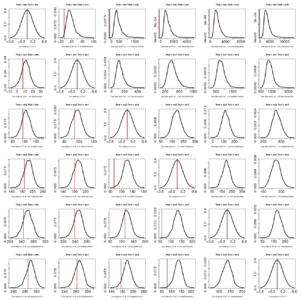New Simulations
- Now have code to run partitioned models on the Anoles dataset, compare partitioned models to the paintings chosen by Butler and King. Preliminary figures below. Models with _s are partitioned by my algorithm, others are the the original ones from earlier.

- Also have examples with simulated data with a known number of partitions, to check the method. Tested with data produced at two peaks on the Labrid tree, the pattern seems similar to that of the Labrids – comparisons involving any model with more than 2 peaks produce LR ratios that become very unlikely in either pairwise comparison. Still needs further exploration. Preliminary figures:

### Interpreting Results
Pattern: In the bootstrapping, the model generating the data always scores substantially higher than the test model, making all distributions fall in the positive range. Note that parameters are fixed, hence the more complicated model does not have an advantage in this bootstrapping. Meanwhile, the more complicated model does substantially better at the real data than the simpler model, since in this case both have there parameters fit to the data. Consequently the red line falls deep in the negative for the bootstraps simulated under the simple model and makes it appear as though the more complicated model is always correct. Perhaps comparing models in which the parameters are allowed to vary may indeed be more meaningful.
Compare to parameter varying case.
Now simulating with parameter varying using simulated two-peak dataset.
Beating bugs and improving code
Found a work-around in the bug that was preventing me from running the Anoles dataset under partitioning. The problem seems to be the reorder.phylo() by pruning order command, which is called by the ace() function on the phylogenetic tree. This function calls a C function to do the reordering, which somehow gets stuck on an infinite loop when given a file converted from ouch format to ape format using my function. Writing my converted tree out to a nexus file with write.nexus() and then reading it back in seems to solve this problem.
Made my convert() function build its “phylo” tree arguments in the same order (edge, Nnode, tip.label, edge.length) as they are assigned in the “phylo” objects created by read.nexus, though this doesn’t seem to matter as most calls are made with phy$edge rather than phy[1].
Code now avoids bootstrapping a model against itself.
Could avoid re-simulating datasets for each figure in the same row, but should profile the code first to make sure this is worth while.
should start logging simulation runs directly and fixing seed.
png and cairo devices haven’t been installed on the server, figures output in pdf and converted to png by imagemagick with bash:
for i in *.pdf; do convert "$i" "${i/.pdf}".png; done- see git log for more details.
Notes
Google Summer of Code includes NesCent “phyloinformatics” research
still reading: open science, part 2, and also enjoyed this
CSGF Conference HPC Survey
- Not directly phylogentics, but also working on today:
- I was contacted by Mary Ann 3 days ago on doing another survey of CSGF fellows. Last year’s survey was pretty basic (results). Also interested to explore alternatives to surveymonkey, though it did make things quite easy and Krell can probably get the subscription. Possibly Google forms?
Some goals I have for the survey:
- Who knows/uses what. Be able to see what languages, parallelization, and scale of computation fellows are computing on. The crucial goal for this year is to be able to break this down by subject area and by year in the fellowship.
- Effective practices in computing. Hugely important but too rarely taught (in sciences anyway). Version control, debugging, visualization, etc. A great example of this stuff is to see the quiz on Software Carpentry(scroll down to #5)
- Science 2.0 This goes a little further afield and might deserve its own session. Computers and the internet continue to change many aspects in the way we do science and it makes sense that CSGFs should be at the forefront. Large-scale online collaborations. The benefits and risks of science blogging. Standardized and publicly accessible data, source code, publications, and notebooks. Social networking for scientists. There’s a wealth of rapidly emerging tools in this area that I think we should all know about. Two quick examples: Mendeley for organizing our collections of scientific papers and stackoverflow.com for solving programming problems collaboratively.